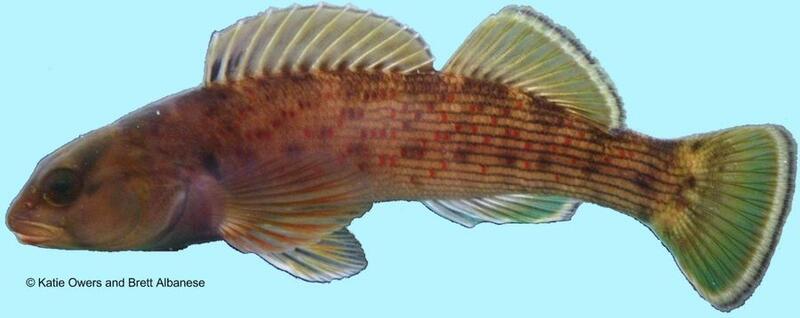







Loading profile. Please wait . . .
Nothonotus chlorobranchius (Zorach, 1972)
Greenfin Darter




Federal Protection: No US federal protection
State Protection: Threatened
Global Rank: G4
State Rank: S1
Element Locations Tracked in Biotics: Yes
SWAP 2015 Species of Greatest Conservation Need (SGCN): Yes
SWAP 2025 Species of Greatest Conservation Need (SGCN): Yes
2025 SGCN Priority Tier: High Conservation Concern
Element Occurrences (EOs) in Georgia: 2
Habitat Summary for element in Georgia: Cool to cold high elevation creeks and rivers in swift current with boulder to bedrock substrate
This is a relatively large, colorful darter reaching a maximum 110 mm (4.3 in) total length, with a compressed body form and a short, blunt snout. The dorsal, caudal, and anal fins are edged by a dark marginal band and a lighter sub-marginal band. A dark bar extends downward from each eye. The sides of the fish are marked by 10-12 dark vertical bars or blotches and 12-15 thin horizontal stripes. Adult males are deep green in color with green fins and brownish red spots along the sides. A nuptial male is pictured above, an unsexed non-nuptial adult is pictured at the bottom of this account.
The Tuckasegee darter (Etheostoma gutselli) also develops green breeding coloration, but differs in having U-shaped blotches along the sides, an extremely rounded snout that is uniquely bound to the side of the upper lip (versus snout separated from side of upper lip by a groove in all other darters), and a longer, more elongated body shape. The wounded darter (Etheostoma vulneratum) is very similar but has more rounded (vs. rectangular-shaped) red spots along the sides of males and lacks the distinctive sub-marginal bands that are present on the dorsal, caudal, and anal fins of the greenfin darter. The wounded darter is not known to co-occur with the greenfin darter in Georgia, but the two species do overlap in the Little Tennessee River system within North Carolina.
The greenfin darter inhabits riffles with swift currents over bedrock, boulder, or cobble substrata in medium to large, high-elevation streams with cool to cold water temperatures.
A wide variety benthic aquatic invertebrates.
Very little is known about the biology of the greenfin darter. Length-frequency data suggests a life span of about four years. Spawning probably occurs during late spring and summer in swift-flowing riffles. Spawning behavior is probably similar to the closely related bluebreast darter (Etheostoma camurum), which is known to be an egg-burying species. During egg deposition and fertilization, females may partially bury themselves in the sand or gravel.
Kick-seining or backpack electrofishing upstream of a stationary net are effective methods. Snorkeling may also be effective.
This darter occurs only in mountain streams of the upper Tennessee River drainage in Georgia, North Carolina, Tennessee, and Virginia. In Georgia, this fish is known from the Little Tennessee River system in Rabun County. Check the Fishes of Georgia Webpage for a watershed-level distribution map.
The primary threat to the greenfin darter in Georgia is stream degradation resulting from failure to employ Best Management Practices (BMPs) for forestry and agriculture, failure to control soil erosion from construction sites and bridge crossings, and increased stormwater runoff from developing urban and industrial areas. Increasing commercial, residential and highway development utilizing poor construction and riparian management practices pose a significant threat to stream habitat quality in North Georgia.
| Threat 1 | Threat 2 | Threat 3 | |
|---|---|---|---|
| General Threat | Pollution | Residential & commercial development | Pollution |
| Specific Threat | Agricultural & forestry effluents | Housing & urban areas | Domestic & urban waste water |
The greenfin darter is only known from the Little Tennessee River system in Georgia, with recent (2009) records known from the mainstem Little Tennessee River and Betty Creek. There is some evidence that greenfin darter populations are increasing in the Georgia portion of its range (Bill McLarney, pers. Comm.).
Conserving populations of the greenfin darter in Georgia will require maintaining and improving habitat quality in the Little Tennessee River system by eliminating sediment runoff from land-disturbing activities such as roadway and housing construction, maintaining and restoring forested buffers along stream banks, eliminating inputs of contaminants such as fertilizers and pesticides, and maintaining natural patterns of streamflow. There are many technical assistance and cost-sharing programs that can help farmers implement best management practices to reduce sediment and nutrient pollution.
Etnier, D. A. and W. C. Starnes. 1993. The fishes of Tennessee. Univ. Tennessee Press, Knoxville. 681pp.
Jenkins, R. E. and N. M. Burkhead. 1993. Freshwater fishes of Virginia. Am. Fish. Soc., Bethesda, Md. 1079pp.
Lee, S. L., C. R. Gilbert, C. H. Hocutt, R. E. Jenkins, D. E. McAllister, and J. R.Stauffer. 1980. Atlas of North American fishes. North Carolina State Mus. Nat. Hist. 867pp.
Page, L. M. and B. M. Burr. 1991. A field guide to freshwater fishes of North America north of Mexico. Houghton Mifflin, Boston. 432pp.
Byron J. Freeman
B. Freeman, 1999: original account
K. Owers, Jan, 2009: updated status and ranks, added fish atlas link, converted to new format, minor edits to text
B. Albanese, Aug, 2009: added pictures, similar species, and conservation status.
Z. Abouhamdan, April 2016: updated links